<< Previous | Displaying results 6101-6150 of 6768 for "" | Next >>
This prewar photo shows newly married Daniel and Laura (née Litwak) Schwarzwald enjoying a day on the beach in Zaleszczyki, Poland (today Zalishchyky, Ukraine). The Schwarzwalds were Jews from Lwów. They married in 1935 and lived in a fashionable Lwów district where Jews were a minority. Both Laura and Daniel pursued university educations and spoke Polish, Russian, German, and Yiddish. Daniel also spoke English. At the time of their marriage, Daniel was a successful businessman. He owned a lumber…

Propaganda played a crucial role in selling the myth of the "national community" (Volksgemeinschaft) to so-called "Aryan" Germans. The photograph on this cigarette card was taken by Nazi propagandist Heinrich Hoffman. It depicts a crowd of people smiling and giving the Nazi salute as a guard holds them back. Written in German, the caption on the back reads, "Every day the same picture: Fans welcome the leader." Beginning in the 1920s, cigarette cards were a popular collectible item in Germany. This card…
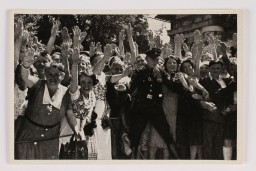
Sir Horace Rumbold was the British ambassador to Germany from 1928 to 1933. Rumbold described for the British government the changes he saw in Germany once Hitler came to power in January 1933. In a dispatch dated April 26, 1933, he warned of the principles outlined in Hitler's Mein Kampf and wrote that "the outlook for Europe is far from peaceful." Undated photograph. Library of Congress, Prints & Photographs Division, LC-DIG-ggbain-36812
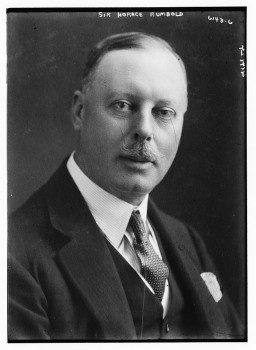
Standing in an open car, Adolf Hitler salutes a crowd in Hamburg, Germany. Photo dated August 17, 1934.
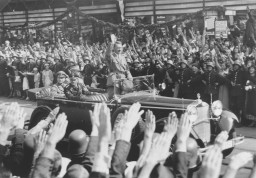
Hitler inspects a German naval warship. On his left is Admiral Erich Raeder. Standing to the right of Hitler is most likely Captain Hermann von Fischel, commander of the Deutschland from April 1, 1933, to December 29, 1935. Bremerhaven, Germany, circa 1933–1935.
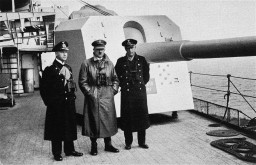
Portrait of British Prime Minister Neville Chamberlain. London, England, 1937–1940.
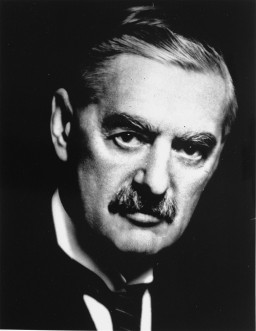
Members of the British Auxiliary Territorial Service carry rifles shipped from the United States under the Lend-Lease Act. Lend-Lease was a US policy that extended material aid to the Allies before and after the United States entered World War II.
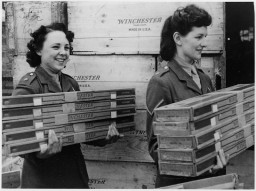
Wearing numbers, the defendants in the Bergen-Belsen Trial sit in the courtroom in Lüneburg, Germany. The Belsen Trial began on September 17, 1945, and was one of the first war crimes trials held after World War II. IWM (HU 59545)
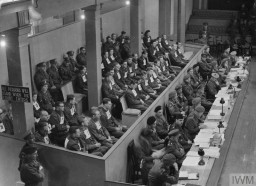
British Prime Minister Winston Churchill sits in the Cabinet Room at 10 Downing Street. London, 1940. IWM (MH 26392)
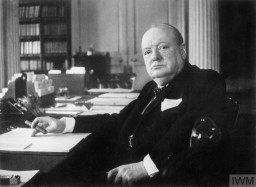
Winston Churchill (seated) at Westminster College on March 5, 1946, the day he delivered his “Iron Curtain” speech. Standing at the far right is US President Harry S. Truman. Behind them (left to right) are Admiral William D. Leahy, Captain Clark Clifford, and Major General Harry Vaughan. Photograph taken by Terry Savage. Fulton, Missouri.
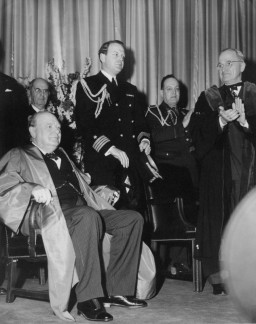
British Prime Minister Winston Churchill (far right) and others view buildings damaged during the Blitz. The Blitz was a German bombing campaign over Britain that lasted from September 7, 1940, to May 11, 1941. London, September 8, 1940. IWM(H 3978)
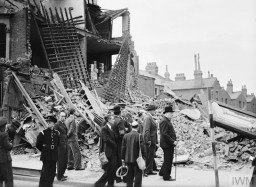
British Prime Minister Neville Chamberlain addresses a crowd at the Heston Aerodrome on September 30, 1938. He has just returned from signing the Munich Agreement with Germany, Italy, and France. Chamberlain will later deliver a statement at the prime minister’s residence at 10 Downing Street, where he famously proclaims, “I believe it is peace for our time.” IWM (HU 4255)
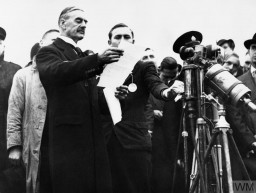
Destroyers of the Royal Navy carry British troops evacuated from Dunkirk. Dover, England, May 31, 1940. IWM (H 1640)
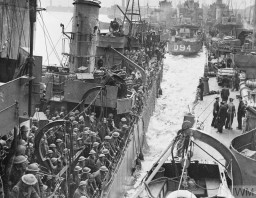
President Franklin D. Roosevelt and British Prime Minister Winston Churchill during the Atlantic Conference on Placentia Bay in Newfoundland, Canada. Also pictured are the president’s sons, Franklin D. Roosevelt, Jr. (far left) and Elliott Roosevelt (far right). August 9, 1941.

A sergeant pilot of the British Royal Air Force sits in the cockpit of his Spitfire in September 1940. Between July 10 and October 31, 1940, Germany and Britain fought for air control of the English Channel in the Battle of Britain. IWM (HU 104502)
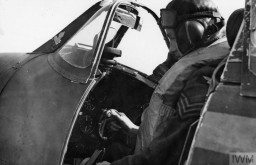
Sergeant Leon Bass and other members of the all African-American 183rd unit witnessed Buchenwald several days after liberation.
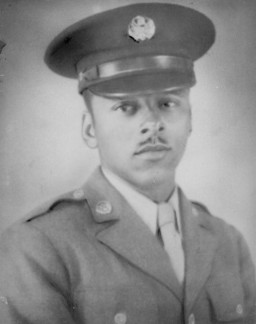
Police search members of the SA (Sturmabteilung) for weapons as they gather for a rally. This photo was taken during the years of the Weimar Republic, before the Nazi rise to power. Germany, 1929–1932.
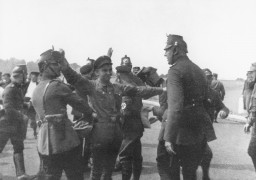
Collage created after the Nazi regime began to force gay and lesbian gathering spaces to close. It was published in the magazine, Der Notschrei. Berlin, March 1933.
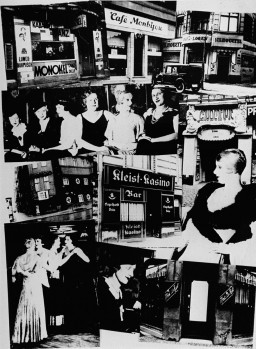
Group portrait at the Children's Aid Society (Oeuvre de Secours aux Enfants, OSE) home for Orthodox Jewish children in Ambloy, France. Among those pictured: Kalman Kalikstein (front left), Binem Wrzonski (middle right), and Elie Wiesel (back center). Photo dated 1945–1946.
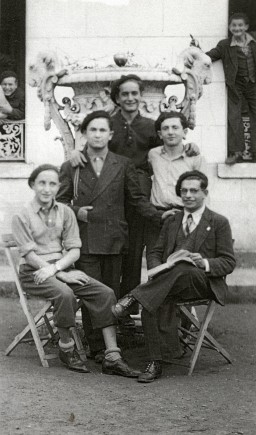
Michael Fink and his parents Manfred and Herta in the Westerbork camp, 1941–1944. Westerbork's primary role was as a transit camp. However, there was also a long-term camp population there. The Finks were among these residents. The family was in Westerbork until the spring of 1944, when they were deported to Theresienstadt. Michael and Herta survived, but Manfred was killed after being deported to Auschwitz-Birkenau and other concentration camps.
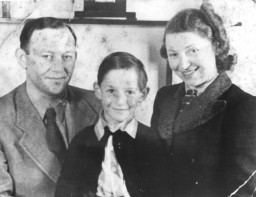
Signed portrait of German physician and sex researcher Magnus Hirschfeld (1868–1935). Hirschfeld sought to educate the public about sexuality. He advocated for the decriminalization of sexual relations between men, which was banned under Paragraph 175 of the German criminal code. Photo dated November 12, 1927.
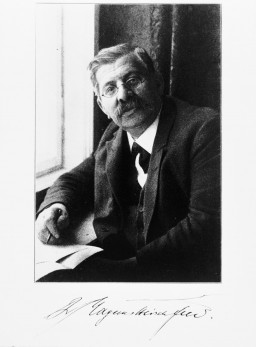
The American Eugenics Society displays an exhibit on health and eugenics at the Kansas Free Fair in 1929.
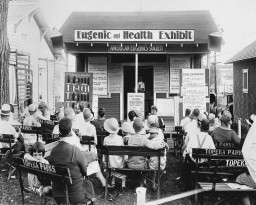
A segregated drinking fountain on the county courthouse lawn in Halifax, North Carolina. Photographed by John Vachon in April 1938.
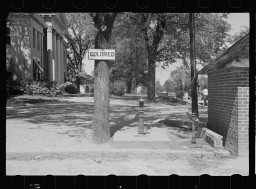
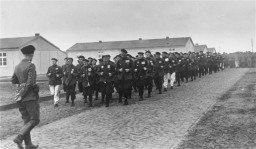
View of the wall enclosing the Esterwegen concentration camp, 1936.
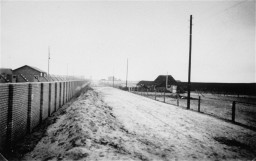
The defendants and their lawyers at the International Military Tribunal trial of war criminals at Nuremberg. Defendant Albert Speer (standing at right) delivers a statement in the dock. Nuremberg, Germany, November 20, 1945-October 1, 1946.
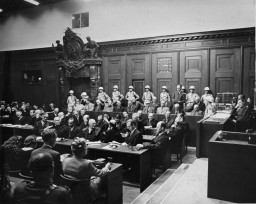
Julien Bryan was an important US documentary filmmaker and photographer who captured the everyday life, work, and culture of individuals and communities in many countries around the globe. Bryan was filming in western Europe in the summer of 1939. In the first week of September 1939, Bryan made his way to Warsaw just as all foreign reporters, diplomats, and Polish government officials were fleeing the capital in the wake of the German invasion. One of the few foreign photographers left in the city, he…
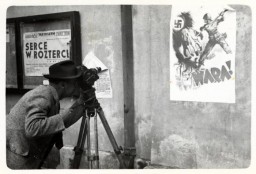
Adolf Hitler salutes a passing SS formation at the third Nazi Party Congress in 1927. Nuremberg, Germany, August 1927. The SS (Schutzstaffel, or Protection Squads) was originally established as Adolf Hitler’s personal bodyguard unit. It would later become both the elite guard of the Nazi Reich and Hitler’s executive force prepared to carry out all security-related duties, without regard for legal restraint.
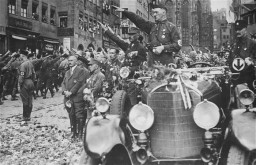
A prewar photograph of Basia and Moshe Golden (Gordon) taken ca. 1922–1925 in Swieciany, Poland (now Lithuania). Basia, along with two of their four children, Boruch and Teyva, were shot at the Ponary killing site by SS men and their Lithuanian collaborators in September 1943. Moshe died in the Klooga concentration camp. Two of their children survived, Niusia and Rwya. This photograph was saved by Niusia (now Anna Nodel) while she was in hiding.
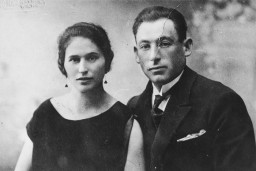
Prewar portrait of Pinchas and Roza Zygielbojm taken in 1936 in Warsaw, Poland. In 1942, they were taken into the Ponary forest outside of Vilna and killed by the SS and Lithuanian collaborators. Born in 1906, Pinchas Zygielbojm was an actor and brother of Szmul Artur Zygielbojm, a leader of the Jewish socialist Bund in interwar Poland and later a member of the National Council of the Polish Government-in-Exile in London.
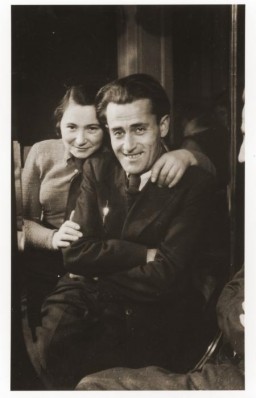
Shlomo Trabska was one of the many Jewish victims who were shot by the SS and Lithuanian collaborators at the Ponary killing site outside of Vilna. This photograph was taken in the late 1930s, when Shlomo was serving in the Polish army.
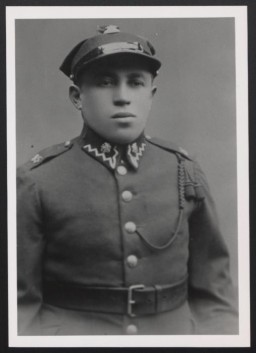
Execution site in the Ponary forest outside the Vilna ghetto. Lithuania, 1941.
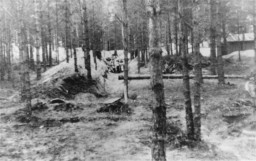
SS guards and Lithuanian collaborators force Jewish men into the Ponary forest, a site for mass killings outside of Vilna. German-occupied Lithuania, 1941.
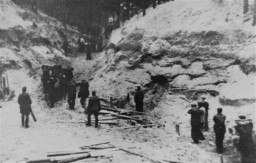
Jewish men are led to a site in the Ponary forest outside of Vilna, where they will be shot by Lithuanian collaborators, commanded by members of a German Einsatzgruppe. 1941.
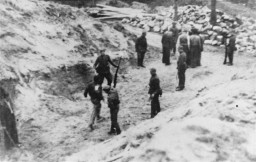
Two Jewish men, wearing badges identifying them as Jews, stand before SS men in the Ponary forest outside Vilna. Ponary served as the main Nazi killing site for Vilna's Jewish inhabitants. ca. July 1941.
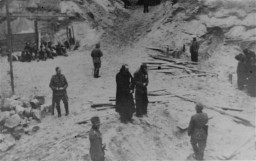
The Institute for Sexual Science was founded in Germany by Dr. Magnus Hirschfeld, a leading researcher of sex, sexuality, and gender. In 1933, the Nazis looted the institute and forced it to close. Photo published in 1924.
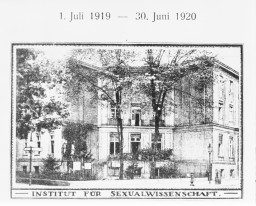
In February 1929, the Nazi newspaper "Der Stuermer" depicted a caricature of Magnus Hirschfeld. The Nazi Party attacked Dr. Hirschfeld for his ideas about sex, sexuality, and gender, as well as his Jewish ancestry.
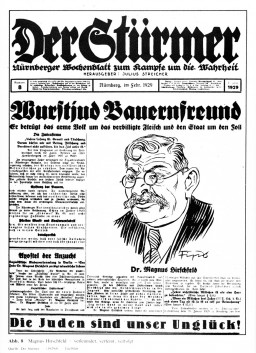
A newspaper clipping with the headline "Against the Un-German Spirit" announces the plundering of the Institute for Sexual Science. The photo shows students marching to the institute's entrance before the looting began on May 6, 1933. The institute's books and documents were among those targeted during the Nazi book burnings.
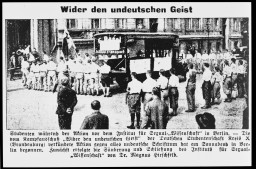
Students sit at their desks in a classroom at a Polish-language public elementary school in Lwów around 1930. In interwar Poland, Jewish children could attend public or private schools. The curriculum in these schools was based on a secular education, in contrast to the traditional heder where boys were schooled in Jewish texts and traditions. This particular school was located in the city’s predominantly Jewish neighborhood and almost all of the students were Jewish. Before attending this school,…

This group portrait shows instructors of the Hanoar Hatzioni Zionist youth movement at a summer camp in Lwów in 1936. The uniforms the young men wear, combined with the summer camp setting, bear similarities to the wider European scouting movement. Between World War I and World War II, scouting was very popular in Poland among young people. Scouting had a strongly national character. It inspired youth movements for Jews, who were excluded from scouting or who wanted to express their own national…
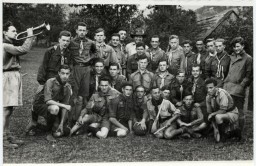
Siegfried Graetschus (right) and an unidentified man stand in front of Grafeneck, the first killing center established under Aktion T4 (the Nazi Euthanasia Program). Before joining the T4 program, Graetschus worked at the Sachsenhausen concentration camp. Photo dated early 1940.
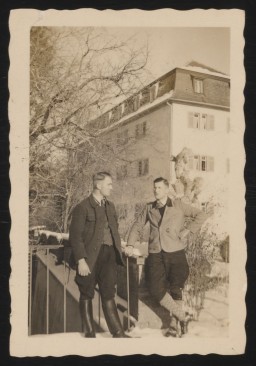
Johann Niemann (left) and an unidentified man walk on the snow covered driveway to Grafeneck Castle in early 1940. Niemann worked as a stoker at Grafeneck, cremating victims' corpses in the crematoria. He later became the deputy commander of the Sobibor killing center.
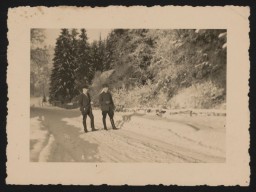
A family stands outside of their wagon while interned in a Zigeunerlager ("Gypsy camp"). In the background, children are crowded around Eva Justin. Justin worked for the Center for Research on Racial Hygiene and Demographic Biology. Schleswig-Holstein, Germany, 1938. During the Nazi era, Dr. Robert Ritter was a leading authority on the racial classification of people pejoratively labeled “Zigeuner” (“Gypsies”). Ritter’s research was in a field called eugenics, or what the Nazis called…
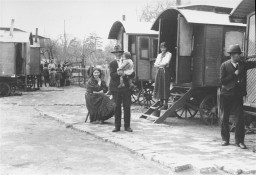
A Jewish refugee couple poses on the gangway of the MS St. Louis as they disembark from the ship in Antwerp. Belgium, June 17, 1939.
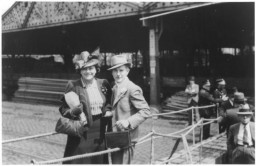
The following list of Jewish partisans features personal stories from the Jewish Partisan Educ...
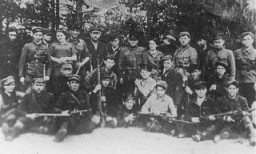
Learning about the Holocaust is one way to honor those lost. Browse our learning site for students as a resource for Holocaust-education projects.
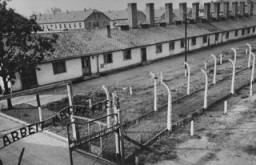
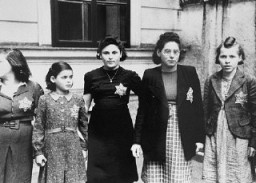
Diaries reveal some of the most heart-wrenching accounts of the Holocaust. They record the feelings of loss, fear, and sometimes hope of those facing extraordinary peril.
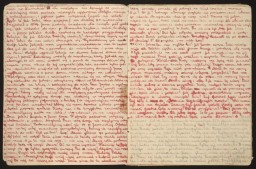
Explore the history of Jews in Ukraine before, during, and after the Holocaust through articles, personal stories, historical photographs, artifacts, maps, and more.
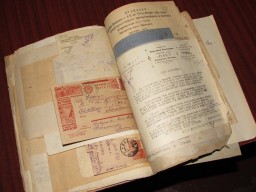
Key principles, strategies, and people in the history of Nazi propaganda during the Nazi rise to power, the Third Reich, "Final Solution," and World War II.
We would like to thank Crown Family Philanthropies, Abe and Ida Cooper Foundation, the Claims Conference, EVZ, and BMF for supporting the ongoing work to create content and resources for the Holocaust Encyclopedia. View the list of donor acknowledgement.